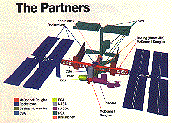NEEP533 Course Notes (Spring 1999)
Resources from Space
Lecture # 35 Second, we kill all the lawyers, again!
Title: Legal Regimes for Space Enterprises
- Outer Space Treaty of 1967
- Over 90 states, including the US, are parties
- Drew heavily on the Antarctic Treaty
- Has broad acceptance, with many principles taken from international customary law
- The Treaty:
- pertains to the exploration and use of outer space, including the Moon and other celestial bodies
- activities shall be for the benefit and in the interest of all countries
- space shall be the preserve of all "Mankind"
- provides free access to all nations
- provides for freedom of scientific investigation and encourages international cooperation
- states that outer space is not subject to national appropriation
- provides that the Moon and other celestial bodies shall be used only for peaceful purposes
- provides that state parties shall be responsible for continuing supervision of national activities
- states that activities will be conducted with due regard to interests of other parties
- provides that a state party retain jurisdiction and control over objects it places in outer space
- states that activities on the Moon and other celestial bodies will be conducted so as to avoid their harmful contamination
- provides for consultation if there is a potential for harmful interference with the activities of others
- provides for the disclosure of the nature of activities undertaken in outer space
- provides for reciprocal inspection rights
- provides for an amending process
- provides for withdrawal upon a one year notice
- No specific rules for mineral development on the Moon
- mineral development not precluded
- activities governed by the Treaty and other international law
- Moon can be used for peaceful purposes
- activities not restricted to scientific purposes
- territorial claims are precluded, but "use" is not
- national or private ownership of resources removed is not preclude
- general, but unspecified obligation to share benefits with all countries
- exclusive use of installations implied by the provision for advance notice of inspection and right of jurisdiction
- activities by non governmental entities are permitted
- entities obligated to avoid harmful contamination but broader obligations not spelled out
- strong commitment to advance notification and consultation if interference with others is a possibility
- states are internationally liable for their activities and those under their jurisdiction
- The Moon Agreement of 1979
- Negotiated in the UN Outer Space Committee
- Entered into force in 1984 with five countries having ratified - a few more since
- Major space powers have not ratified, including US, Russia, China, Japan,
- To a large degree, repeats the obligations contained in the Outer Space Treaty
- New obligations/rights include:
- samples can be remove and retained
- resources may be used to support activities on the Moon
- prevention of the disruption of the existing environmental balance
- free access of other parties cannot be impeded
- the statement "The Moon and its natural resources are the common heritage of mankind.."
- agreement, in Article 11, to undertake to establish an international regime to govern the exploitation of lunar resources "as such exploitation is about to become feasible"
- orderly and safe development
- rational management
- expansion of use
- equitable (not defined) sharing of the benefits
- informing the public of any natural resources discovered
- US did not sign or ratify due to concerns about the interpretation of the "common heritage" language in light of the history of the Law of the Sea Convention
- one view is that the phrase contemplates a moratorium on use of lunar resources
- other view is that the phrase has never had a fixed meaning and the negotiating history of the Moon Treaty supports this view
- Extent of agreement on "common heritage" phrase as it might relate to lunar resources
- mining areas not subject to national appropriation
- shared management responsibility
- sharing of economic benefits
- use for peaceful purposes
- free and open scientific research
- concern for protection from environmental harm
- No management regime established
- Article 11 expressly contemplates a separate negotiation without preconditions other than those already accepted for outer space activities
- Any disagreeing state will not be legally bound by whatever management regime is defined by this negotiation
- It does not appear that the use of the phrase "resources may be used to support activities on the Moon" was intended to preclude broader use of such resources
- Detailed environmental obligations left open
- No consultations held in 1994 or since as scheduled due to lack of interest in returning to the Moon.
- INTELSAT Agreement of 1964
- Result of Kennedy decision to share US communications technology with the world
- Major provisions:
- applies to space segment only
- purpose to provide international public telecommunications via satellites
- membership open to any member of the International Telecommunications Union (ITU)
- benefits of space made available to all through access to satellite communications
- user-based control, i.e., shares based on percent utilization of the system
- US initially would have had majority control but voluntarily limited share to 40% (now much less)
- INTELSAT can act as a legal entity
- nondiscriminatory pricing structure for its services
- thinly used links subsidized
- Currently reorganizing into a public corporation
- Major problem has become inability to compete with private communications systems due to requirement to subsidize thinly used links
- INMARSAT Agreement of 1976
- Same structure as INTELSAT for mobile maritime communications
- Expanded into land mobile communications
- Recently spun off a public corporation to compete in satellite-based mobile communications
- Lessons Learned?
- User-based, international organizations like INTELSAT and INMARSAT, with narrow and achievable objectives, work, at least until competitive services become inevitable
- every party has always paid their bills to retain what is perceived to be indispensable service
- Designed to improve service to an existing market
- International Space Station (ISS) Intergovernmental Agreement (IGA) of 1988
- Signed by US, Europe (ESA), Japan, and Canada
- Original agreement based on Antarctic and Space Treaty-like arrangements
- Innovative provision on criminal jurisdiction
- Each party responsible for funding and building is contribution to the ISS
- US (NASA) responsible for launch, integration, and overall management
- Withdrawal allowed with 1 year notice
- Russia invited to join after several redesigns of ISS
- Revised IGA in negotiation (CRS 1996)
- Phase I (1994-1998): joint Space Shuttle and Mir activities
- Phase II (1997-1999 and slipping): Russia will build and launch the central core module (providing GN&C), provide re-boost through a Progress Module, and provide Crew Return Vehicles (Soyuz), in support of US power and habitation modules.
- Back-up systems in design and test by the U.S., however, if required, a significant additional schedule slip would occur and costs would increase.
- Phase III (2000-2004 and slipping): European, Japanese, Canadian, and Russian research modules added.
- Crew command agreement reached in November 1997 (Space News, Nov. 24-30, p 17)
- US command for flights one and three
- Russian command for flights two and four
- Major Issues resulting from Russian participation
- Political stability of Russia
- Relations between Russia and the U.S. relative to other international issues (Serbia, Iraq, North Korea, China, etc.)
- Adequate funding for its commitments
- Russian participation originally linked to its adherence to the (Ballistic) Missile Technology Control Regime (MTCR) and to the transfer of large sums (about $590 million as of 1996) of US dollars.
- more dollar transfer(>$400 million) as result of missions to Mir and supply of Mir
- US Congress worried about ISS dependency on Russian performance and stability
- Original savings (2 years and $4 billion) have disappeared.
- Russian launches depend on good relations with both Kazakistan and Ukraine.
- NASA's own technical and political issues are formidable
- Launch schedule margins
- Shuttle operations and funding
- Extravehicular Activity requirements
- Congressional support
- NASA justification for continuing work with Russia
- Need Russian MIR experience for successful ISS
- U.S. justification for continuing work with Russia
- Keep Russian scientists and engineers employed and away from employment by rogue nations.
- Lessons Learned?
- Do not negotiate agreements piecemeal.
- Insure that all parties have a vested interest in the success of the enterprise.
- Start with as simple an engineering and operational design as the principle goal of the enterprise permits.
- Although developments have endangered the success of this Agreement, it does provide some precedents on cooperation between partners each with significant technical and financial resources to bring to the table.
- The INTERLUNE model for international management of a lunar enterprise (see Schmitt, 1992)
- Modeled largely after the INTELSAT and INMARSAT agreements
 |
from Launchspace, June/July 1997, p.41 |
- Parties involved:
- Nations
- Traditional parties to treaties and international agreements
- Users and customers
- Part of the INTELSAT and INMARSAT systems
- Investors
- Non-traditional parties but now part of the INTELSAT and INMARSAT public corporations
- Assembly of Parties - member nations
- Policy authority
- ~ Shareholders
- Board of Governors - major contributing nations
- Operational authority over the Director General
- ~ Board of Directors
- Board of Users and Investors
- Represented on the Board of Governors
- Present recommendations affecting the interests of users and investors
- Influence a function of the level of dependence on investment capital and user payments
- Director General and staff
- Operation and Management
- Judicial Tribunal
- Final arbiter of internal disputes related to interpretation of the Charter
- Final court of appeals in criminal and civil matters
- World He-3 energy and Environment Foundation
- Recognizes "common heritage" and "environmental heritage" themes of modern international law
- Third World nations and UNEP would be among the beneficiaries
- Assist in the broad utilization of fusion power
- Assist in countering the effects of global change whatever its cause may be
- Provision for Self-Determination
- Seats for permanent settlers on the Assembly of Parties, Board of Governors, and Judicial Tribunal
- Incentive compensation for permanent settlers
- Provision for accumulation of voting shares by permanent settlers
- Recognition that the success of INTERLUNE will ultimately guarantee political and financial control if desired
- Ancillary goals of INTERLUNE
- Develop a customer base
- Seek a competitive return on investments
- ensure the neutrality and security of its activities
- Implementation will be difficult without an aggressive commitment by the US
- Window of opportunity has probably closed on this option
References:
Bilder, et. al., 1989, Legal Regimes for the Mining of
Helium-3 from the Moon, WCSAR-TR-AR3-8901-1, p54-79.
Congressional Research Service (CRS), 1996, Space Station,
Issue Brief, 3/20/96.
Schmitt, H.H., 1992, INTERLUNE Concept for Helium-3 Fusion
Development, in W.Z. Sadeh, et al., editors, Engineering, Construction,
and Operations in Space III, p804-814.
 |
|
University of Wisconsin Fusion Technology Institute · 439 Engineering Research Building · 1500 Engineering Drive · Madison WI 53706-1609 · Telephone: (608) 263-2352 · Fax: (608) 263-4499 · Email: fti@engr.wisc.edu |
Copyright © 2003 The Board of
Regents of the University of Wisconsin System.
For feedback or accessibility issues, contact
web@fti.neep.wisc.edu.
|

